Best Program for Modern Notation Chant?
-
Can anyone recommend a good program for publishing chant in modern "stemmed" notation, i.e. eighth and quarter notes with episemata/tenuto marks as needed and cue-sized notes to indicate liquescence? I've tried Finale and Sibelius and found both to be extraordinarily tedious for getting unmetered music to look decent on the page for anything longer than a single line. I would prefer to avoid any sort of program or font that requires manual alignment of each syllable. I have very little experience with LilyPond and would appreciate any advice as to whether it might be useful for chant or other unmetered music.
-
There was a discussion about stemless notation with Finale vs. Sibelius some time ago. In it, I posted how it can be done rather easily, together with a "worksheet" PDF illustrating just how it was done for my setting of 'The morning star is on the rise' ... the relevant forum page is (the worksheet is fairly far down the thread):
https://forum.musicasacra.com/forum/discussion/12198/the-great-debate-finale-vs.-sibelius/p1
This approach really does remove the tedium of separately counting notes for each "measure" and setting a time signature for each ... my trick is to start with all 1 beat (1/4) measures (hidden time signature, of course), combine measures as necessary for "neumes" or melismas, using invisible barlines and altered default spacing before and after "music" in each measure (these are all set at the beginning, or even incorporated into a stemless chant notation Finale template). Feel free to contact me for more information or help. -
You might try Noteflight.com. It's a web and cloud based music notation application. Mouse interface is pretty intuitive to use, but when you learn keyboard shortcuts that speeds the notating process quite a lot.
Basic membership to use the application is free, which gives you access to quite sophisticated notation tools and would be more than adequate for what you are looking for. So it would cost you nothing to try it out except the time in learning how to do what you want to do with it.
For chant you'll want to change the time signature of each measure to accord with the musical phrasing (total time value of all the eighth and quarter notes) and hide the time signatures so it's just a plain measure of notes. Easy to do. I've done things with it similar to what you say you want to do.
Thanked by 1madorganist -
Lilypond supplies helpful examples, called snippets :-
Ancient notation template – modern transcription of gregorian music
This example demonstrates how to do modern transcription of Gregorian music.
Gregorian music has no measure, no stems; it uses only half and quarter note heads,
and special marks, indicating rests of different length.
\include "gregorian.ly"
chant = \relative c' {
\set Score.timing = ##f
f4 a2 \divisioMinima
g4 b a2 f2 \divisioMaior
g4( f) f( g) a2 \finalis
}
verba = \lyricmode {
Lo -- rem ip -- sum do -- lor sit a -- met
}
\score {
\new Staff <<
\new Voice = "melody" \chant
\new Lyrics = "one" \lyricsto melody \verba
>>
\layout {
\context {
\Staff
\remove "Time_signature_engraver"
\remove "Bar_engraver"
\hide Stem
}
\context {
\Voice
\override Stem.length = #0
}
\context {
\Score
barAlways = ##t
}
}
}
(click on the picture to see it properly ! )
 lily-11d7938f.png307 x 75 - 4K
lily-11d7938f.png307 x 75 - 4K -
I use LilyPond. The great thing is that once you have a template, for which you can use the "snippet" above or something like it, it's very simple to create new documents.Thanked by 1madorganist
-
With LilyPond, you could define snippets for every necessary aspect of Gregorian notation and insert them into the score at your leisure with one simple command, and have it automatically typeset as best as possible.Thanked by 1madorganist
-
Thanks, everyone. I'll tinker with the snippet and give LilyPond a try, also CHGiffen's link. I do want to repeat that I'm interested in standard stemmed round notes, not stemless. I think a couple of you misread that above.Thanked by 1CHGiffen
-
If you want stemmed notes, just don't turn on the stemless option.Thanked by 1madorganist
-
Hello again everyone! Do any of you have experience using Dorico for modern notation chant? We have some extra money in the music fund at year end and I'm considering purchasing this software. I have achieved nice looking results with Sibelius, but it really take a lot of work, including much dragging and dropping with the mouse, which unfortunately results in carpal tunnel pain for me. I'm hoping there's an easier way to get more consistent note spacing.
-
ServiamScores is forever singing the praises of Dorico, so I hope he'll see your post and chime in!
-
Here's an example of stemless notation made with Lilypond:


 Screenshot_20211221_194309.png558 x 677 - 84KThanked by 1Brian Michael Page
Screenshot_20211221_194309.png558 x 677 - 84KThanked by 1Brian Michael Page -
The melisma on the third line is a little spaced out for my taste, but not bad! At least the spacing is uniform, even if there isn't text underneath. Thanks for sharing that. Does anybody happen to know what software was used for the German Catholic hymnal Gotteslob?
-
Here's a stemless version of the Mode I Pange lingua gloriosi ("Another chant" from pp.950-952 in the LU).

 Pange lingua gloriosi-Mode I-hymn.pdf56K
Pange lingua gloriosi-Mode I-hymn.pdf56K -
And here it is with stems turned on.
N.B. Both were engraved using Finale, with my own tricks, described above and in another thread.

 Pange lingua gloriosi-Mode I-hymn-stems.pdf61K
Pange lingua gloriosi-Mode I-hymn-stems.pdf61K -
ServiamScores is forever singing the praises of Dorico, so I hope he'll see your post and chime in!
Yes I am! Lol!
I love Dorico. Love, love, love it. For chant transcriptions, I think it is one of the best options available because it supports truly open meter music. In fact, when you start a project, there are no bars and there is no meter at all. There are simply staves waiting for you to do something. Consequently, you can type in phrases of irregular length, and then just plop barlines (tick, half, full, double, ... whatever) wherever you want them. If you make a mistake and need to add or subtract, it's as simple as using the shift+b "popover" to add or subtract beats and you can add or take them away anywhere in any bar. There is also "insert" mode which can shift everything very quickly.
You can also hide any rests you want very easily. This makes for doing NOH style accompaniments very easy because the number of beats doesn't have to match (Dorico will calculate the correct number of beats, but you can override that and hide them anyway). Put notes where you need them in the accompaniment to line up, and then press a hotkey and hide the unneeded rests, and boom, you're golden.
Also, Dorico is just about to release a new version (right after New Years) so if you buy a copy of it now, you'll get a free upgrade to version 4.0 in a few weeks.
The quality of the engraving is excellent, too.
I'm attaching one of the pew cards that I made for our parish, a funerary hymn which I wrote and rendered an NOH esque accompaniment for, and lastly one of my chant-based psalm settings.
In this last example, I was able to add the image of the chant at the top from within Dorico itself via an images frame.
Edit: I forgot to mention that you can control oodles of defaults, so you can change note spacing both in quantity and ratio to other notes, and then there is a dedicated "note spacing" sub-mode within the engraving area where you can manually space notes as well to get them just right.
 Missa XVII alternate layout • Landscape 2-up (1).pdf89K
Missa XVII alternate layout • Landscape 2-up (1).pdf89K
 Jesus, Lord, Have Mercy (Organ + Chant combined).pdf186K
Jesus, Lord, Have Mercy (Organ + Chant combined).pdf186K
 Psalm 45 • The Queen Stands at Your Right Hand (Astitit Regina) CHOIR EDITION.pdf291K
Psalm 45 • The Queen Stands at Your Right Hand (Astitit Regina) CHOIR EDITION.pdf291K -
I’ve got tons of Lilypond examples. I really think it is the fastest way to enter unmetered notation. I would not recommend the snippet posted here above, but I have other solutions and templates which I have posted to the forum before, if you want to search for them.
I would be happy to provide advice too, if you PM me. -
There is no way that coding into lilypond is the “fastest”, lol. It might look fantastic, but you have to be ready for the working model, and the barrier to entry is high.
-
Once the templates are developed, it is pretty fast for creating a score for a new piece. You can just enter the notes and words, without having to format a whole score like in MuseScore or Sibelius.
I have read about some features in Dorico that sound like it is good for unmetered music, but it’s expensive. -
Thank you all! Here is Gloria Patri VII as an example of what I'm trying to do:
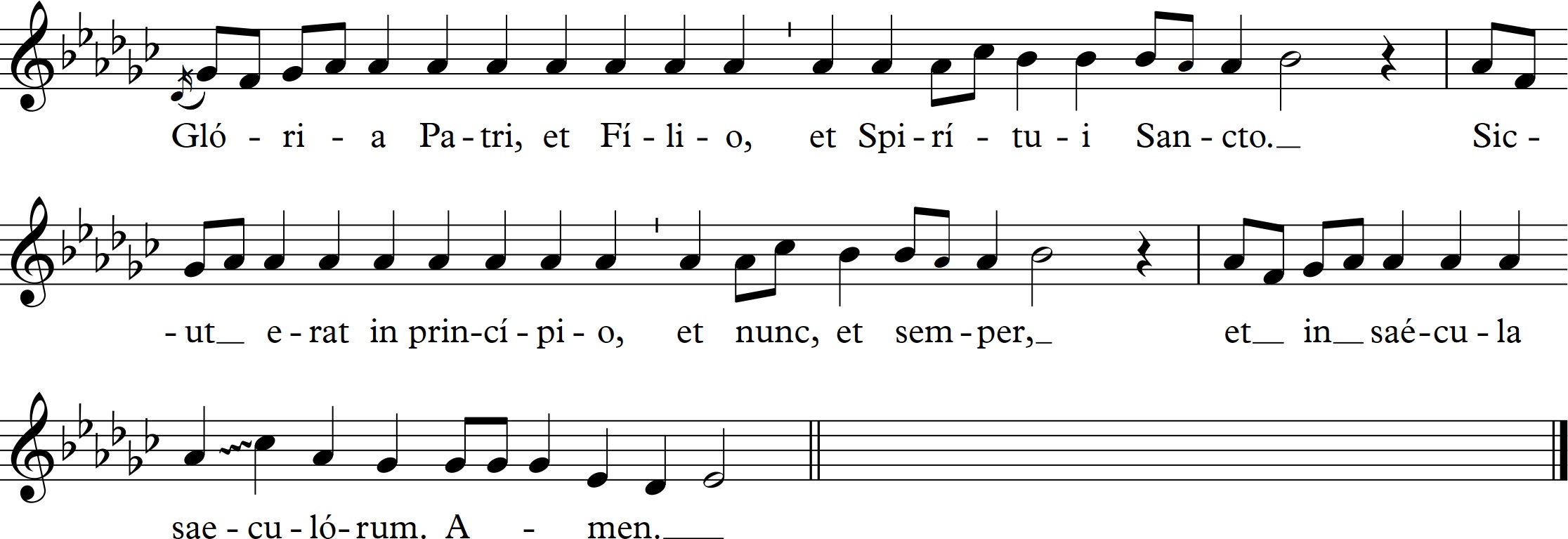
You will notice a key signature, sixteenth-note acciaccatura grace note with slur for the intio debilis note at the beginning, quarter ("tick") bar lines, small notes for the liquescents at Sancto and semper, and glissando/portamento for the quilisma at saeculorum. It took me about twenty minutes in Sibelius, but this syllabic chant did not require extensive changes to note spacing. Would it be easier to get equivalent or better results with Lilypond or Dorico?
 Gloria Patri VII.jpg2232 x 767 - 257KThanked by 1CHGiffen
Gloria Patri VII.jpg2232 x 767 - 257KThanked by 1CHGiffen -
Templates speed any program up, Dorico included.Once the templates are developed, it is pretty fast for creating a score for a new piece. You can just enter the notes and words, without having to format a whole score like in MuseScore or Sibelius.
It is, and it is. (It's worth it though; and very few people pay full price. As long as you have some version of another program, you can cross-grade. There are also academic discounts.)I have read about some features in Dorico that sound like it is good for unmetered music, but it’s expensive. -
Here's a Lilypond version of that GP:
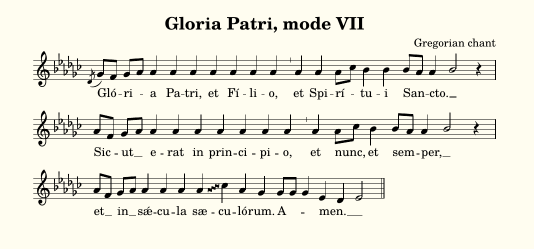
It took me about 40 minutes to create this from scratch, though a chunk of that time was spent in trying to imitate unusual details of the score, such as the representation of the quilisma. What notation did you use for that? Mine was a long prall, shifted and rotated.
(PS: I missed notating the liquescents with a small note head. It would just take a few seconds more to do that.)
 Screenshot_20211223_034337.png534 x 249 - 30K
Screenshot_20211223_034337.png534 x 249 - 30K
 Gregorian-chant-Gloria-Patri-mode-VII.txt2KThanked by 1madorganist
Gregorian-chant-Gloria-Patri-mode-VII.txt2KThanked by 1madorganist -
Probably 15 minutes on Dorico, though as I'm still quite new to the program I spent some of that time looking up the (now that I know, very fast) way of changing notehead size, and learning to switch to engrave mode to graphically pull around symbols like the quilisma - though I'm not yet sure how to get a fatter type.
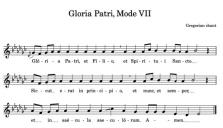
 561631F7-4AC8-430E-B95D-F0D1B9A76CEA_4_5005_c.jpeg536 x 308 - 46KThanked by 1madorganist
561631F7-4AC8-430E-B95D-F0D1B9A76CEA_4_5005_c.jpeg536 x 308 - 46KThanked by 1madorganist -
Thank you both!
In Sibelius 7.5, it's labeled Glissando (wavy).the quilisma. What notation did you use for that -
I also will say that Dorico pushes you in general not to use manual dragging but rather to play with universal engraving settings to achieve the look you want. (Though you can still do so.) My workflow:
1 Open project with single voice
2 Add titles
3 Remove staff labels and measure numbers
4 Add key sig
5 Input notes with MIDI keyboard (a little faster, but not much, than entry using the keyboard abcdefg)
6 Add text
7 Add barlines (quarter bars and normal bars are separate one-click options from a selection)
8 Change beaming (with hotkeys)
9 Change notehead size (selected both and took three clicks to change)
10 Add quilisma (glissando, dragged slightly in engrave mode)
11 Increased overall note sizing to achieve better look -
I use Capella. It's a little pricey ($248 in US funds), but I like that you don't have to insert time signatures (most make you do so), and just insert bars wherever you'd like. Also, you can draw quarter bars and half bars freehand. Overall, I find it very powerful.
My work in progress, "Christus Vincit Gradual" is done with Capella.
http://cvmusic.christusvincit.com/
Capella Website: (company is German-based, but you can get the software in German, English, or French)
https://www.capella-software.com/us/
BMPThanked by 1madorganist -
I was curious, so I timed it. This took me exactly 7:55. (Edit: make that 9 minutes because I had to go back and add the cue-sized notes which I forgot the first time.)
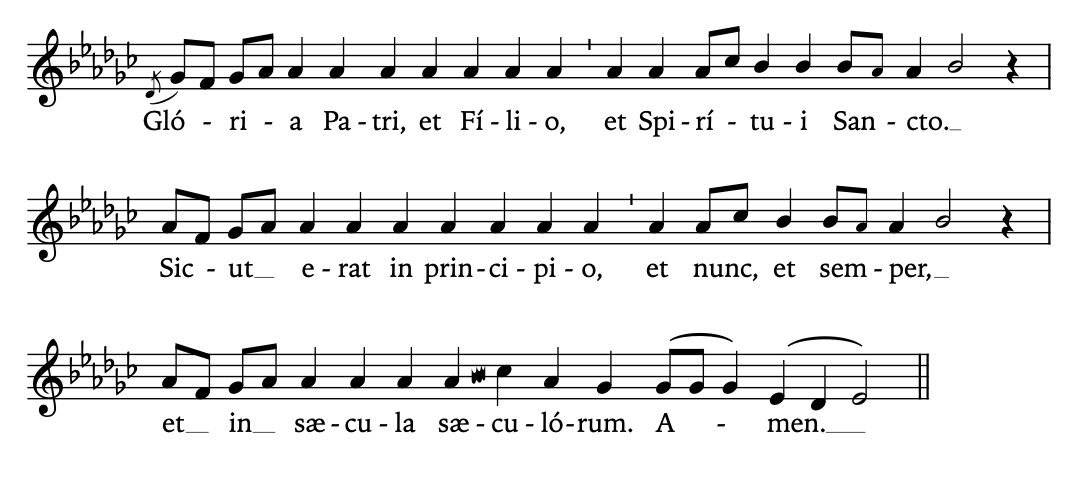
PS: MRTaylor-- to change the font, go to engrave mode > engrave > font styles > lyrics font.
 Screen Shot 2021-12-23 at 12.54.55 PM.png1086 x 484 - 79KThanked by 1madorganist
Screen Shot 2021-12-23 at 12.54.55 PM.png1086 x 484 - 79KThanked by 1madorganist -
@ServiamScores you missed the liquescents. :) EDIT: nevermind!
And how do you get the third line to terminate early? -
Via the note spacing sub-mode in engrave mode. Click the icon on the upper left that has horizontal arrows; a bunch of boxes will appear all over screen; select the larger box that is at the bottom right of that stave, and then alt+arrow it over. (cmd+alt+arrow is faster)Thanked by 1m_r_taylor
-
7 Add barlines (quarter bars and normal bars are separate one-click options from a selection)
BTW: it's really easy to add these as you go via the barline popover. Shift+B works while you are in note entry mode, (and you don't exit note entry mode when you invoke this option) so you can be in the middle of putting in the notes, and plop the barlines in as you go.
You'd type in:
"tick" or '
half
| (pipe character) or "normal"
|| for double
Here's the page that has the shortcuts you can type in: https://steinberg.help/dorico_pro/v3.5/en/dorico/topics/write_mode/write_mode_notations_input/write_mode_bars_barlines_popover_r.htmlThanked by 1m_r_taylor -
By the way, does that notation really represent the rhythm of how you perform that Gloria Patri?
-
It is a little hard not to imagine: this:

 Untitled Document-7.pdf5K
Untitled Document-7.pdf5K -
Considering I use the Solesmes method week in and week out, no. Does it represent how the oldest sources notate introit psalm verses? Most certainly; cf. the attached examples from Murray and Blackley:By the way, does that notation really represent the rhythm of how you perform that Gloria Patri?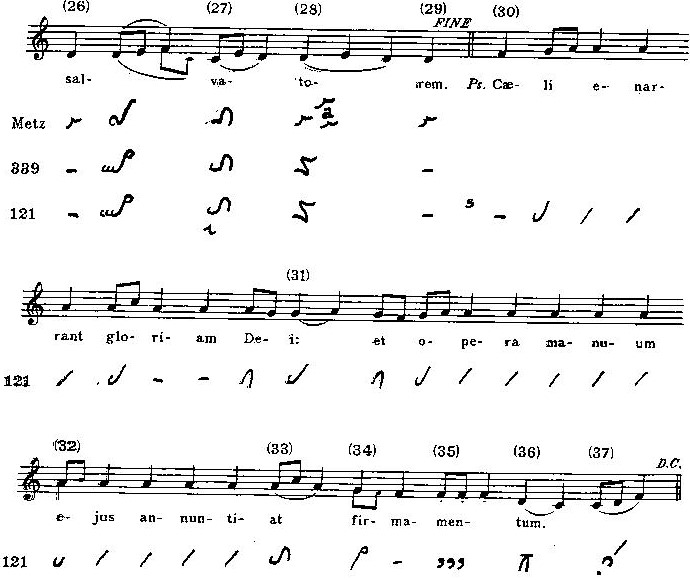
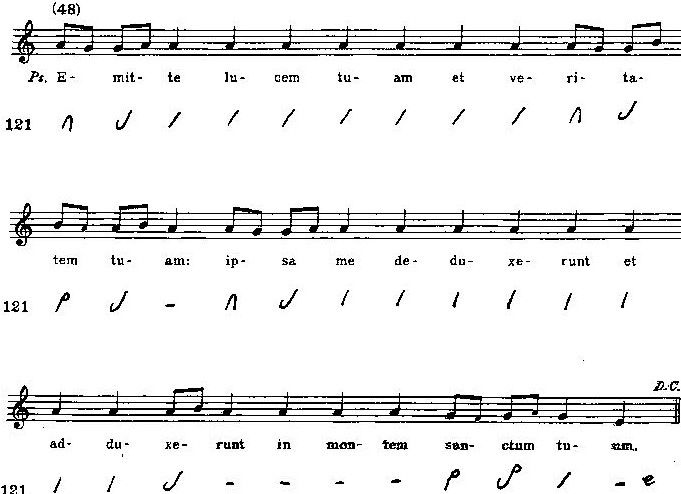
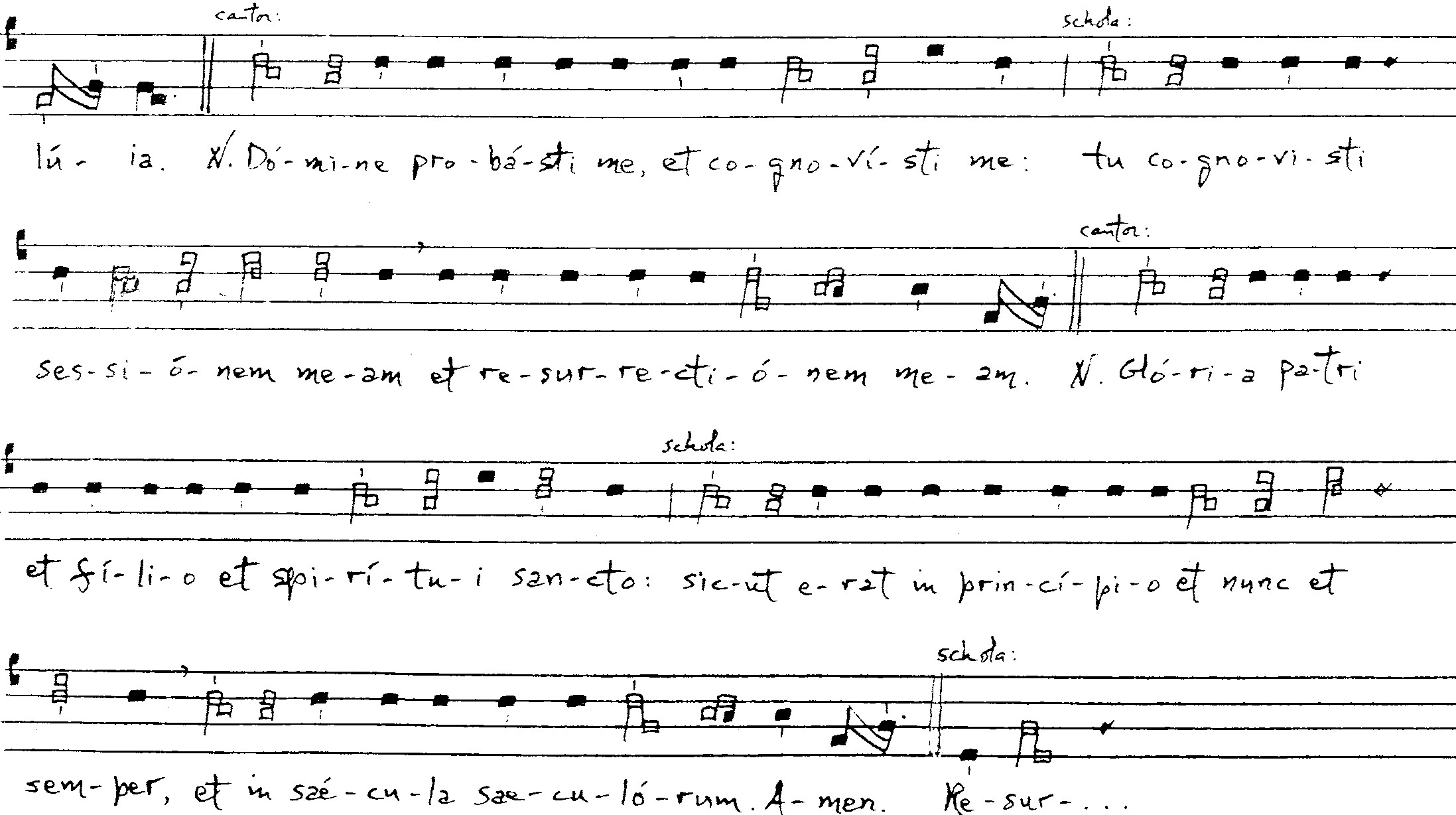

 and the Cantatorium website. Many recordings in that style can be heard on this channel: https://www.youtube.com/channel/UCM1uEmpb9_JgPJhOPqDwctw/videos
and the Cantatorium website. Many recordings in that style can be heard on this channel: https://www.youtube.com/channel/UCM1uEmpb9_JgPJhOPqDwctw/videos
and here—Midnight Mass, no less:
https://www.youtube.com/watch?v=dxTmL_WvCpw
with the actual liturgical recording including multiple Communion verses here:
https://www.youtube.com/watch?v=V3T41tfpBxU
The long notes at the mediant cadence are editorial; the tenth-century scribes unanimously write them as shorts.
 Co Pascha Ps Cantate.jpg1117 x 436 - 145K
Co Pascha Ps Cantate.jpg1117 x 436 - 145K
 In Judica Ps Emitte.jpg681 x 494 - 96K
In Judica Ps Emitte.jpg681 x 494 - 96K
 In Resurrexi Ps Domine probasti.jpg2195 x 1228 - 428K
In Resurrexi Ps Domine probasti.jpg2195 x 1228 - 428K
 In Rorate Ps Caeli.jpg690 x 580 - 116K
In Rorate Ps Caeli.jpg690 x 580 - 116K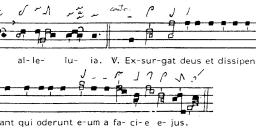
 In Spiritus Ps Exsurgat.jpg2218 x 635 - 250KThanked by 1Elmar
In Spiritus Ps Exsurgat.jpg2218 x 635 - 250KThanked by 1Elmar -
Do fa mi fa sol LA for mode VII? Bizarre.It is a little hard not to imagine: this: -
I think Richard meant the rhythm.
-
I don't think his transcription demonstrates a solid understanding of the torculus initio debilis. As for the double note values on the reciting tone, see the above examples.I think Richard meant the rhythm. -
I have some doubts about whether quarter- and eighth-notes are a good representation of how the passages above were sung in the past or should be sung now.
-
Madorganist, I think he understands just fine. He’s questioning the method of representation in your example, and observing that the rhythm that may be implied is what he posted.
(This, for the record, is why I use stemless transcriptions. With stemless people are much more apt to sing in natural speech rhythm. It’s difficult to “deprogram” choirs to not imply rhythm when stems are present, at least in my experience.)
Many transcriptions that use stemmed notation use all eighths, or all quarters (with dots added in where needed) but don’t whiplash between eighths and quarters like this, to avoid this very pitfal. -
I would suggest Musescore.
I have used it to do modern notation of Brager's "Adoremus in Aeternum" and the Gregorian "Parce, Domine", "Dear Maker of the Starry Skies."
As with any music program there is a learning curve. Once you master the steps it becomes easier. Musescore has a nice Forum and help section online. In Musescore, I've learned you have to determine the smallest note value and set the measure count up accordingly for example in Adoremus in Aeternum, the first measure 27/8. I did this whole piece in one measure, so the total count was 81/8, then use the "split staff before note" function to obtain 3 measures or staffs. If the smallest count is a sixteenth note, then you have to count in 16s instead of 8s. You can also do stemless notes.
 Adoremus_in_aeternum.pdf45K
Adoremus_in_aeternum.pdf45K
 Parce,_Domine.pdf55K
Parce,_Domine.pdf55K
 Dear_Maker_of_the_Starry_Skies.pdf41KThanked by 1madorganist
Dear_Maker_of_the_Starry_Skies.pdf41KThanked by 1madorganist -
In case it was not clear enough from previous comments and examples, the mensuralist transcription in the style of Murray is meant to indicate measured, proportional rhythm. I would counter that choirs who are accustomed to accentualist, "free," or "nuanced" styles of interpretation experience difficulty reading Gregorian notation in strictly proportional rhythm, i.e. with all longs exactly double shorts, but we know from contemporaneous writings that that's how it was actually sung.(This, for the record, is why I use stemless transcriptions. With stemless people are much more apt to sing in natural speech rhythm. It’s difficult to “deprogram” choirs to not imply rhythm when stems are present, at least in my experience.)
Many transcriptions that use stemmed notation use all eighths, or all quarters (with dots added in where needed) but don’t whiplash between eighths and quarters like this, to avoid this very pitfal.
According to Jan van Biezen:
But his translator, Kevin Rooney, points out in a footnote thatIt has to follow that the psalm verses in an Introit (or Communion) shall be sung faster than the associated antiphon, even though one favors the calm, deliberate, full pronunciation of the psalm verses—and not the usual machine-gun-like reciting employed under the guise of 'oratorical rhythm.'
So, this is a matter of some controversy. Why not seek out a performance practice that corresponds to the evidence of the oldest sources?Actually, the Commemoratio brevis calls for an exception in the canticles, the Benedictus and Magnificat, "which are sung so slowly that their antiphon should follow at the same tempo" (translation by Terence Bailey). Since the psalm verses of Introit and Communion show the same solemnity of decoration as the canticles, it follows that they too are to be sung at the same tempo as their antiphons, i.e. half the tempo of the normal psalm verses.Thanked by 1CHGiffen -
Why not seek out a performance practice that corresponds to the evidence of the oldest sources?
Some of us reject the very concept of "period performance" on principle. Whether that was the performance practice of whichever era is irrelevant to me; I regard it as unmusical and counter to a text-based interpretation that harmonizes with the remainder of the chants of the Mass.Thanked by 1Andrew_Malton -
There’s also the very real possibility that the “earliest” sources are wrong, or more likely, only accounting for a snapshot in time at one particular place. It’s very possible that the performance practice was even corrupted by the time they were writing, or that what they observed was neither universal nor “best” practice.
It’s my understanding that the living tradition of chant had nearly died by the time it was revived in the 19th century which is why there were multiple theories in circulation about its proper interpretation. To be perfectly frank, as someone who has done a reasonable amount of chanting and led choirs in it for a few years, I cannot fathom not singing in natural speech rhythm. That’s not to say that we don’t observe some of the expected articulations, particularly lengthening at cadences, or that the rhythm of speech is unregulated or uneven. But it is to say that we do what makes the best sense aurally, not unlike how verses of Anglican chant are handled.
But, wading into historical particularities is above my pay grade and I have to get back to prepping for tonight. -
It's worth noting that the practitioners of the style sevère in the interpretation of Bach's organ works could point to a direct lineage of instruction and plenty of historical documentation to justify a completely arbitrary, un-natural, un-nuanced, and un-musical approach that almost nobody questioned for decades. All those who profess the "one true" approach to any interpretation should bear this well in mind, particularly those versed in external sources rather than internal evidence.Thanked by 1ServiamScores
-
Which chants would those be? The collect, epistle, gospel, and other chants sung according to a formula are accentus, liturgical recitative, but the choral chants are something different, concentus. It's a bit like saying that recitatives, arias, choruses, and chorales all require the same style of interpretation. (In fact, I worked with a colleague who insisted on a "chant-like" recitation of the opening bars of "The Lord gave the word" in Handel's Messiah instead of a robust, double-dotted declamation, if you can imagine).a text-based interpretation that harmonizes with the remainder of the chants of the Mass. -
It’s my understanding that the living tradition of chant had nearly died by the time it was revived in the 19th century
That is indeed the French way of looking at it.Thanked by 1Andrew_Malton -
Would the tropes of the Kyrie make musical sense unless the notes were more or less equal? Can we deduce that, at the time they were written, performance was without the trills and catches one hears in some modern interpretations.
-
I'm sure madorganist must know his audience, butchant in modern "stemmed" notation, i.e. eighth and quarter notes with episemata/tenuto marks as needed and cue-sized notes to indicate liquescence?
sounded as if it were describing Hymnal 1940 style, with unbeamed quavers for puncta and crochets where Solesmes puts dots. Murray doesn't use grace notes, does he?
Without going into what the word "represent" represents, if one has a specific notion of how the rhythm goes why wouldn't one go the whole way and write modern notation à la Britten? -
I worked with a colleague who insisted on a "chant-like" recitation of the opening bars of "The Lord gave the word" in Handel's Messiah instead of a robust, double-dotted declamation, if you can imagine).
And yet the practice of double-dotting itself that you describe is precisely the kind of historical fiction that I mentioned, developing of necessity from the slow tempi of the nineteenth century and yet having no support whatsoever from any contemporary documents, as well as being a completely unworkable concept from an ensemble standpoint. It is these flawed proclamations and others that make me more skeptical of the period performance movement as I grow older.Thanked by 1Andrew_Malton -
@Richard Mix:
He does! Nos. 37 & 11Murray doesn't use grace notes, does he?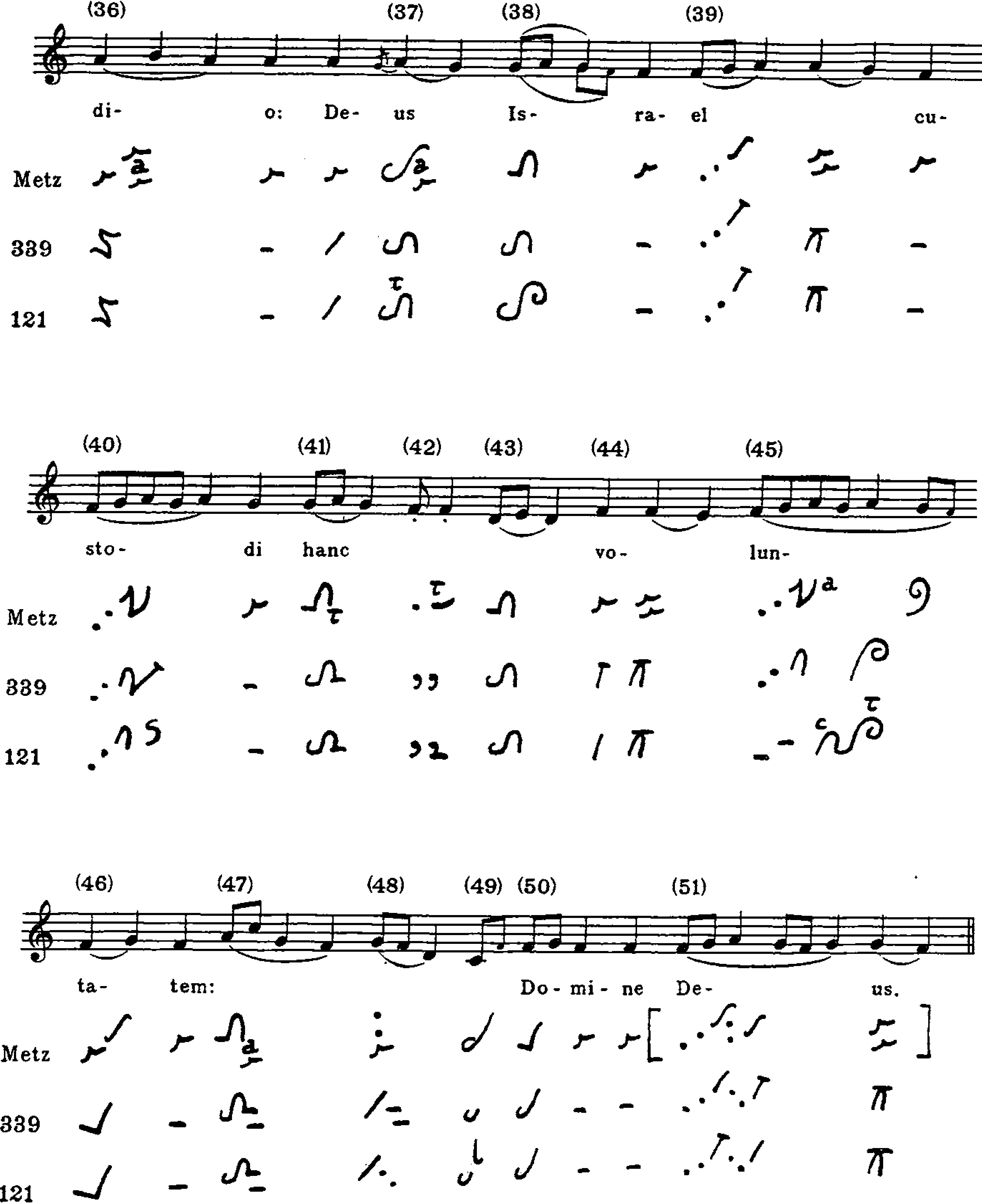
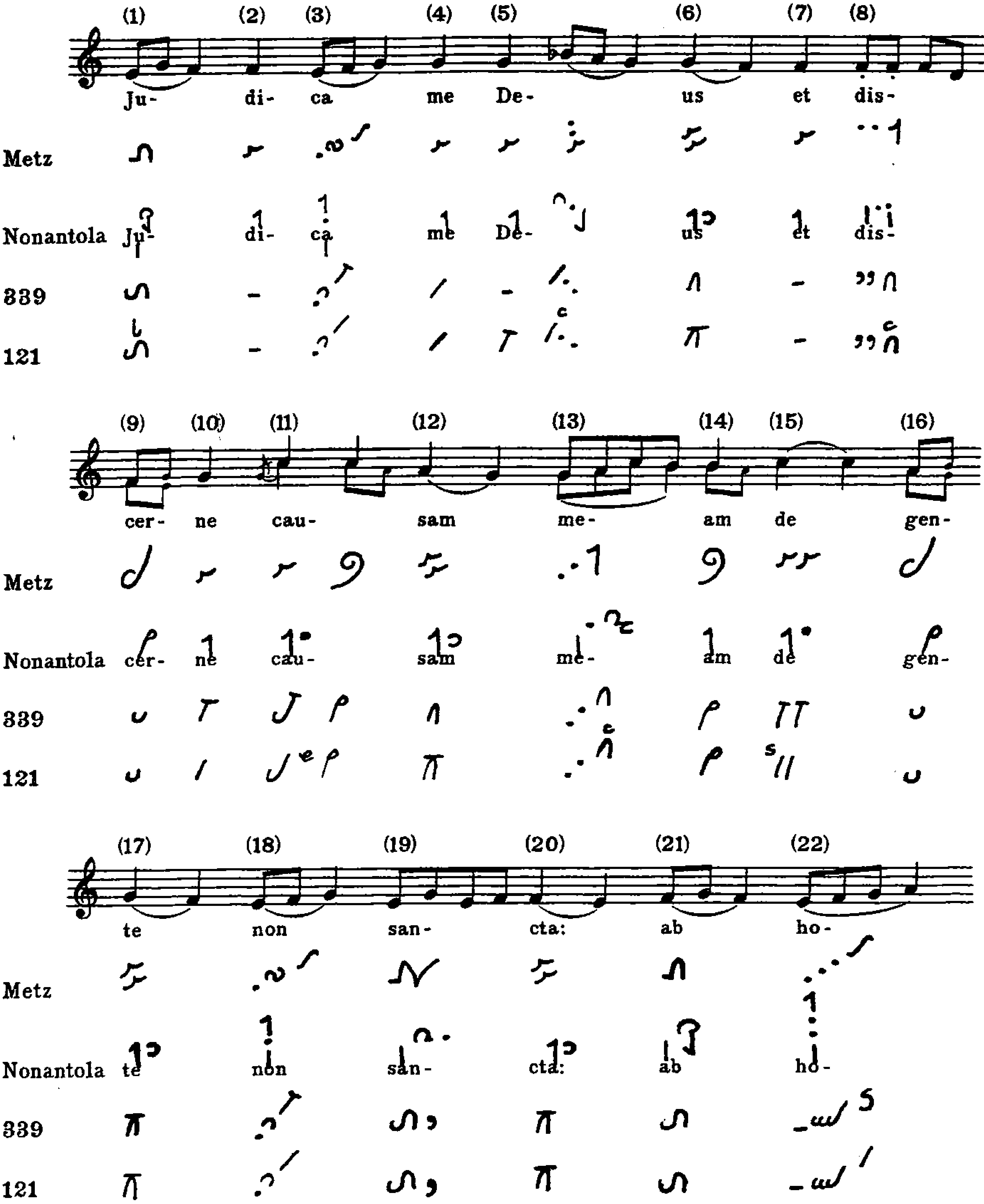
Could you post an example? The Murray transcriptions are the same style Van Biezen uses. Blackley's are similar to the Cantatorium website, but the latter use the episema over long notes instead of making short notes white.if one has a specific notion of how the rhythm goes why wouldn't one go the whole way and write modern notation à la Britten?
@Schönbergian:
A year ago, I requested evidence for nuanced, non-proportional chant rhythm before Mocquereau. The collective knowledge of our forum participants produced a single reference to one book from the mid-18th century—more than eight centuries removed from our earliest manuscripts. See the thread here. The semiologists have discarded Dom Mocquereau's ictus theory but continue to propagate his nuance theory. Luca Ricossa, whom I don't believe is active in this forum, has quipped that Dom Cardine was a mensuralist ignoring himself. You see that I, too, am skeptical of performance practices that have no support whatsoever from any contemporary documents.yet having no support whatsoever from any contemporary documents
 Murray 1.jpg5494 x 6734 - 2M
Murray 1.jpg5494 x 6734 - 2M
 Murray 2.jpg5541 x 6777 - 3MThanked by 1Richard Mix
Murray 2.jpg5541 x 6777 - 3MThanked by 1Richard Mix -
Yes, but I don't propose that my interpretative approach, which is one of many after all, is the only true or even the most correct method for all of Christendom.You see that I, too, am skeptical of performance practices that have no support whatsoever from any contemporary documents. -
Like I said, I use "old Solesmes" week in and week out, but I would hardly regard it as the most correct method, let alone the only true one. The Liber Usualis has deficiencies in rhythm, melody, and even text, otherwise there would be no need for the Graduale Novum or duplex/triplex editions in general. It's the product of fine scholarship from a century ago, but we have more historically accurate rhythmic theories to work with today.
Welcome to the MusicaSacra Forum!
To participate in the discussions on Catholic church music, sign in or register as a forum member, The forum is a project of the Church Music Association of America.
Categories
- All Discussions21,059
- General Music Discussion8,196
- Job Openings191
- Management of Music Programs850
- Choral Matters532
- Church Documents and Rubrics524
- CMAA Notes300
- Events712
- For Newcomers: Read First26
- Sacred Polyphony546
- Hymnody871
- Gregorian Chant: General2,694
- ↳ Graduale Romanum and Liber Usualis367
- ↳ Graduale Simplex60
- ↳ Semiology63
- Vernacular Plainsong695
- Anglican Use and Anglican Chant69
- Organ, Other Instruments and Repertoire434
- New Composition/Works in Progress1,287
- Recordings229
- Music for Hispanic Ministry159
- Music Education: Children211
- Music Education: General222
- News Items245
- Positions Wanted2
- General Discussion: Catholicism738
- Amusements176
- General Discussion1,033
- Opinions117




